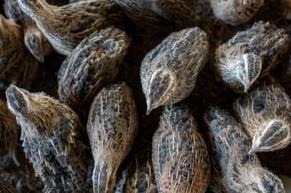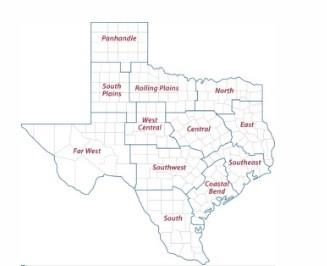State regulatory and animal health agencies reported positive cases of highly pathogenic avian influenza in Texas, according to a Texas A&M AgriLife Extension Service expert.

Quail in a commercial production operation in Gonzales. Game birds from a commercial operation in Erath County were tested and confirmed as the first reported case of highly pathogenic avian influenza in Texas. (Texas A&M AgriLife photo by Sam Craft)
Now AgriLife Extension and faculty in the Department of Poultry Science at Texas A&M University are providing educational information for producers and the public regarding the positive cases and recommendations to mitigate commercial and backyard flock exposure to the disease.
The U.S. Department of Agriculture Animal and Plant Health Inspection Service, APHIS, and Texas Animal Health Commission, TAHC, confirmed the first case of highly pathogenic avian influenza, HPAI, in Texas on April 2.
Greg Archer, Ph.D., AgriLife Extension poultry specialist, Bryan-College Station, said the first positive tests were from a game-bird operation in Erath County.
Infections were found in pheasants produced for hunting. A mixed-bird flock at the location, including pheasants, quail and ducks were euthanized, but a 14-day quarantine period for a 6-mile radius surrounding the isolated game ranch is underway.
APHIS and TAHC will continue to monitor birds, including backyard poultry flocks, within the perimeter during the quarantine. Any positive tests during that time will expand the quarantine perimeter and subsequently reactivate the 14-day quarantine period.
“They feel relatively confident this is an isolated incident because of the ranch’s location,” Archer said. “But we need people with backyard flocks to be especially diligent about reducing birds’ exposure to wild birds as the spring migration continues.”
Biosecurity, monitoring key to mitigating spread
Archer said the ongoing investigation has not determined how the avian flu pathogen was introduced to birds in this incident, but it is suspected to have been “tracked in” by people working in the facility, such as bird feces on the bottom of a boot.
This form of avian influenza has not “jumped” from birds to humans, Archer said.
“It is a disease that becomes very obvious in birds very quickly, and so we need people with birds to report incidents where they have a lot of birds getting sick or declining and dying very rapidly,” he said. “But we also want to reassure the public we are not seeing cases of human sickness related to this pathogen.”
Archer said commercial poultry producers are very well versed in biosecurity but should be extremely vigilant at this time. Texas’ backyard producers should also be practicing higher levels of biosecurity and limiting their flock’s exposure to wild birds.
Backyard producers should be mindful of any situation that increases the risk of exposure – such as food and water sources that can be accessed by both wild birds and poultry flocks or bird feeders and baths near their flock, Archer said.
Any sudden increases in the number of sick birds or bird deaths should be immediately reported to the TAHC at 1-800-550-8242 and/or USDA at 1-866-536-7593.
Avoiding a major outbreak in Texas
More than 23 million commercial and backyard poultry birds in 24 states have been impacted by the ongoing outbreak, according to the USDA.
Major outbreaks in U.S. poultry flocks, including turkeys, egg-laying and broiler facilities, led to the loss of more than 50 million production birds in 2015. Archer said he did not recall any Texas commercial poultry operations being impacted during the 2015 outbreak.
But Texas has been actively preparing alongside the USDA to respond to the disease, said Andy Schwartz, DVM, TAHC executive director and state veterinarian.
“We’d like to encourage Texas poultry owners to educate themselves on this disease and be vigilant in taking steps to protect their flocks from avian influenza,” he said.The Texas A&M Veterinary Medical Diagnostic Laboratory, TVMDL, will test samples during the quarantine period.
The TVMDL tested bird samples received from the ranch. Positive test results for avian flu were sent to and confirmed by the APHIS National Veterinary Services Laboratory in Ames, Iowa.
“Hopefully this is an isolated event, and we go the next two weeks without another incident,” Archer said. “But it is important that Texans take this seriously for the health of their birds and to limit the impact this disease has on commercial poultry production in the U.S.”
AgriLife Extension district reporters compiled the following summaries:

A map of the 12 Texas A&M AgriLife Extension districts.
CENTRAL
Some rainfall, including some severe weather, was reported in the area. Most counties reported short soil moisture levels. Several rangeland and pasture fires occurred. Corn fields emerged nicely given the dry conditions at planting. Fieldwork and hay planting occurred. Limited acres of cotton were planted as most producers waited on moisture and better conditions. Grazing oats and rye were greening up now and some grazing was taking place on these fields. Pest pressure was low overall, but leaf and stripe rust were showing up at low levels on the lowest leaves. There were also good populations of lady beetles, indicating building aphid populations. Cattle were still receiving supplemental feed, and livestock were in fair condition overall. Stock tanks were holding steady. Pastures were showing some signs of improvement with the recent moisture.
ROLLING PLAINS
Scattered rain delivered rainfall amounts up to 0.6 of an inch. Winter wheat conditions were still very poor. Some green-up in pastures helped wildlife and livestock on pasture. Minimal fieldwork was done thus far. Cotton farmers needed to list and plow, but dry conditions were delaying fieldwork. Corn and sorghum planting was behind due to lack of moisture. Some sorghum farmers received decent moisture and were considering planting. Some wheat fields perked up a little following rain. Stock ponds needed a runoff rainfall event to refill. Cattle were being fed hay and supplemental feed.
COASTAL BEND
The district was experiencing abnormally dry to moderate drought conditions. Cotton was being planted as soils warmed up, and some had emerged. Some farmers were still delaying plantings, waiting on rainfall to build soil moisture. Most corn and sorghum had emerged and was doing well, but fields needed moisture. Rice was planted, and some fields were emerging. Vegetable gardens were being planted. Some hay fields were being sprayed for weeds and fertilized. Most rangeland and pastures were in poor condition, but there were a few areas with good enough grazing to maintain livestock body conditions. Cattle producers were culling poor performers and open cows, and the livestock market was still good.
EAST
Drought conditions lessened some, but much more rainfall was needed to improve soil moisture levels. Pasture and rangeland conditions were fair to good. Subsoil and topsoil conditions were adequate. Temperatures were cool in the mornings and much warmer in the afternoons. Cattle markets were steady to higher in some classes. Livestock were doing fair to good with supplemental feeding taking place. High fertilizer prices remained a concern for producers. Texas leaf cutter ants were active. Anderson County reported coyote activity, and feral hogs and gophers caused damage across the district.
SOUTH PLAINS
Wildfire danger and high wind warnings were reported. Very small amounts of rain fell in all counties. Subsoil and topsoil moisture levels improved but were still short. More moisture will be necessary to plant crops. Winter wheat was in good condition. Cattle were also in good condition.
PANHANDLE
The district received scattered showers, but much more was needed to restore soil moisture and crop conditions to normal. Soil moisture levels were very short to short. Overall, crop, rangeland and pasture conditions were very poor to poor. Producers with irrigation were watering wheat to get some growth for stocker cattle. Supplemental feeding of cattle continued.
NORTH
Soil moisture levels were adequate. Some areas received 1-2 inches of rainfall. Temperatures cooled some with the weather fronts. Pastures were greening up. Wheat fields made a turnaround the past couple of weeks following rain and sunshine and was in mostly fair to good condition. Rye grass was also doing well. Livestock were starting to seek spring forages, and hay requirements were reducing. Planted crops were emerging.
FAR WEST
Temperature highs reached 91 degrees with lows around 44 degrees. A small storm blew through the district but only delivered trace amounts of moisture and extremely high winds. Blowing sand was piling up due to high winds. Winter wheat looked good. Corn planting began and was nearly complete. Corn acres were down significantly due to lack of moisture and irrigation availability. Sorghum planting should begin soon, however, acres may decline as well. Fieldwork for cotton slowed down as most producers were afraid of disturbing the soil due to the high winds. More growers were shutting the irrigation off because they could not get the soil wet enough to work or plant, but some continued watering fields. Farmers around El Paso were relying on well water and effluent from the city. Watermelon planting should begin soon. Hot peppers were being planted. Growers were starting to see spring weeds and leaves on trees. Cattle were in fair condition, but producers continued to cull herds due to the lack of grazing and high feed costs. Producers started to vaccinate and band lambs and goats. A wildfire burned for two days covering approximately 650 acres in the northern part of Jeff Davis County. Pecan orchards and alfalfa fields were being irrigated.
WEST CENTRAL
Dry conditions continued, and hay reserves were low. Pastures were starting to green up and wheat was starting to grow, providing decent grazing for livestock. Supplemental feeding of livestock continued. Some producers were beginning to cull cattle due to drought and wildfires.
SOUTHEAST
Some areas reported decent rains and one county reported soggy conditions, but most areas remained dry. Rice was being planted. Soil temperatures were warm, and annual grasses and weeds were growing. High fertilizer prices had many producers considering not making applications this year. Wet conditions delayed fieldwork and planting. Rangeland and pasture ratings were very poor to excellent. Soil moisture levels were adequate to surplus.
SOUTHWEST
Dry, windy conditions continued across most areas with no measurable rainfall reported. Rangeland and pasture conditions continued to decline with higher temperatures and lack of moisture. Multiple wildfires were reported across the district, including 7,000 acres reported burned in Kinney County. Corn and sorghum plantings were wrapping up. Winter wheat and corn under irrigation looked good. Cotton planting will begin soon. Supplemental feeding of livestock continued. Producers were culling herds due to ongoing drought conditions. Livestock markets remained steady to high.
SOUTH
Northern and eastern parts of the district reported very short moisture levels while western and southern areas reported short to adequate soil moisture. Conditions were windy and dry, and temperatures were rising. Strawberries were flowering and starting to produce. Farmers were starting to dry-plant fields before insurance deadlines pass. Sorghum was progressing with very little pest pressure, and cotton was being planted with some early planted fields reaching the two- to four-leaf stage. Farmers were planting and irrigating warm-season vegetables. Producers were also irrigating citrus orchards. Citrus, sugarcane, leafy greens and onions were being harvested. Rangeland and pasture conditions were very poor across most of the district. Ranchers were providing heavy supplemental rations to cattle. Producers continued to cull herds, and some were hauling water. Some water wells were running dry, and stock tanks were low. Coastal Bermuda grass was being irrigated. Hay supplies were declining, and feed and hay prices were rising. Cattle prices at market remained steady, but body condition scores were declining in some areas. Wildlife deaths along roadsides were climbing due to lack of forage and browse beyond road ditches. Fire potential was very high due to dry conditions and winds, and some fires were reported.
Source : tamu.edu